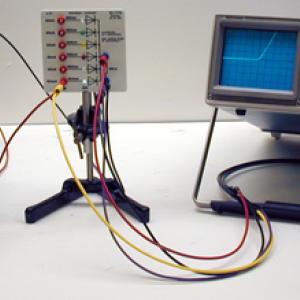College of Liberal Arts & Sciences
7A10.33 - Planck's Constant - LED's
The LED's are designed to be powered off of 6 volts. Use the multimeter to check the voltage if you wish. Hook the oscilloscope across the current resistor and the other lead across the diode. With an xy display a sharp "knee" in the curve is clearly seen. A plot of the "knee" voltage for the 6 different wave lengths of the array should give you measurements for Planck's Constant.
- Feng Zhou, Todd Cloninger, "Computer-Based Experiment for Determining Planck's Constant Using LEDs", TPT, Vol. 46, # 7, Oct. 2008, p. 413.
- Lawrence T. Escalada, N. Sanjay Rebello, and Dean A. Zollman, "Student Explorations of Quantum Effects in LEDs and Luminescent Devices", TPT, Vol. 42, # 2, Feb. 2004, p. 173.
- Charles A. Sawicki, "Simple Uncertainty-Principle Experiment", TPT, p. 84 Vol. 41, # 2, Feb. 2003.
- "LED Correction", TPT, Vol. 35, # 4, Apr. 1997, p. 198.
- D. F. Holcomb, "Apparatus for LED Measurement of Planck's Constant", TPT, Vol. 35, # 5, p. 261, May, 1997.
- D. F. Holcomb, "LED's: Their Charm and Pitfalls", TPT, Vol. 35, # 4, p. 198, April, 1997.
- L. Nieves, G. Spavieri, B. Fernandez, and R. A. Guevara, "Measuring the Planck Constant with LED's", TPT, Vol. 35, # 2, p. 108-109, Feb., 1997.
- David G. Fisher, "Diode Characteristics to Determine Boltzmann Constant", TPT, Vol. 30, # 5, p. 315, May 1992.
- John W. Jewett, "Get The LED Out", TPT, Vol. 29, # 8, Nov. 1991, p. 530.
- Patrick J. O'Connor and Leah R. O'Connor, "Measuring Planck's Constant Using a Light Emitting Diode", TPT, Vol. 12, # 7, p. 423, October 1974.
- Jesus Gonzalez-Laprea, L. J. Borrero-Gonzalez, "Photoelectric Effect Measurements on a Conventional Neon Bulb", AJP, Vol. 89, #10, Oct. 2021, p. 969.
- Jed Brody, Daniel Weiss, Pearl Young, "Observing the Maxwell-Boltzmann Distribution in LED Emission Spectra", AJP, Vol. 78, # 9, p. 933, Sept. 2010.
- Robert Morehouse, "Answer to Question #53, Measuring Planck's Constant by Mean of an LED", AJP, 66, # 1, Jan. 1998, p. 12.
- N. Sanjay Rebello, Chandramouli Ravipati, Dean A. Zollman, Lawrence T. Escalada, "Computer Simulation of p-n Junction Devices", AJP, 65, # 8, August 1997, p. 765.
- F. Herrmann, D. Schatzle, "Question #53, Measuring Planck's Constant by Means of an LED", AJP, 64, # 12, Dec. 1996, p. 1448.
- Graciela Brizuela and Alfredo Juan, "Planck's Constant Determination Using a Light Bulb", AJP, Vol. 64, #6, June 1996, p. 819.
- David A. Johnson, "Demonstrating the Light-Emitting Diode", AJP, 63, # 8, August 1995, p. 761.
- D. Atkinson et. al. XXI International Physics Olympiad: Groningen, The Netherlands, 1990. Am. J. Phys., Vol. 60, # 2, February 1992.
- S-100: "Light Emitting Diodes", DICK and RAE Physics Demo Notebook.
- Charles Day, "Light-Emitting Diodes Reach the Far Ultraviolet", Physics Today, July 2006, p. 15.
- Peter J. Mohr and Barry N. Taylor, "Adjusting the Values of the Fundamental Constants", Physics Today, pp. 29-34, March 2001.
- "Experiment 22 Planck's Constant", Veriner Software & Technology", p. 22-1
- .Jim Overhiser, Gil Toombes, Preeti Chalsani, Ralph Greco, "The Phantastic Photon and LEDs (Combined ab)", CNS Institute for Physics Teachers, June 2010.
- Valeria Indelicato, Paola La Rocca, Francesco Riggi, Gianluca Santagati, and Gaetano Zappalà, "Analysis of LED Data for the Measurement of Planck's Constant in the Undergraduate Laboratory", European Journal of Physics, Vol. 34, #4, July 2013, p. 819.
- Yaakov Kraftmakher, "5.3 Semiconductor Electronics", Experiments and Demonstrations in Physics, ISBN 981-256-602-3, p. 303.
- Jim Glenn, "One Very Small Number", Scientific Genius: The Twenty Greatest Minds, p. 129.
- T. D. Rossing, C. J. Chiaverina, "6.8, Light-Emitting Diodes", Light Science, Physics and Visual Arts, p. 140.
Disclaimer: These demonstrations are provided only for illustrative use by persons affiliated with The University of Iowa and only under the direction of a trained instructor or physicist. The University of Iowa is not responsible for demonstrations performed by those using their own equipment or who choose to use this reference material for their own purpose. The demonstrations included here are within the public domain and can be found in materials contained in libraries, bookstores, and through electronic sources. Performing all or any portion of any of these demonstrations, with or without revisions not depicted here entails inherent risks. These risks include, without limitation, bodily injury (and possibly death), including risks to health that may be temporary or permanent and that may exacerbate a pre-existing medical condition; and property loss or damage. Anyone performing any part of these demonstrations, even with revisions, knowingly and voluntarily assumes all risks associated with them.

